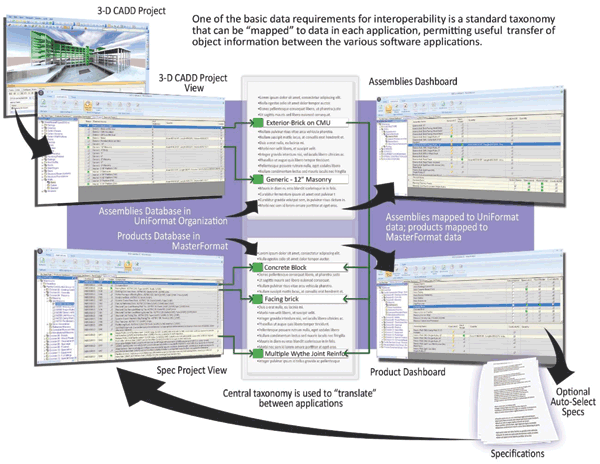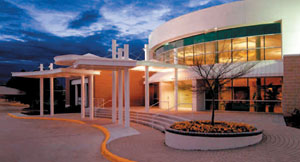BIM Interoperability and Relational Databases
To help illustrate the nature of using a relational database, let's look at a simple example based solely on business data. Architecture firm "A" records all information related to signed contracts as data in a computer flat file with a single table called contracts. In this case, client data must be separately input for each project or contract listed in the table. Since most firms have repeat clients, this separate input duplicates efforts by requiring re-entry and checking of current information while increasing the possibility of errors. By contrast, firm "B" records all contract data in a relational database with two tables called clients and contracts. Records in the contracts table need contain only a reference number to a client, which is fully described only once in the clients table. The RDBMS can then link each contract to the appropriate client for invoicing and other records. In this way, the client information can be updated in one place whenever needed and all affected contracts have the latest information.
 |
Management of drawings, specifications and cost estimates can be greatly enhanced using relational databases. Image courtesy of Building Systems Design, Inc. |
Information in a relational database adds true multi-dimensional depth while maintaining the presentation advantages of word processing and the analytical powers of spreadsheets. In relational databases anyone can quickly compare information because of the arrangement of data in columns within the tables. The relational database model goes on to take advantage of this uniformity by building completely new tables out of selected information from existing tables. In other words, it uses the relationship of similar data to increase the speed and versatility of the database.
So, how does all of this data management relate to the design process? Well, it relates in more ways than most people may realize. Modern CADD and so-called Building Information Modeling (BIM) programs employ RDBMS for optimal storage and retrieval of data related to design elements. Every element in a BIM model comes with editable attributes that are stored as data in a table. The relationship and linkages between the data in different elements of a BIM assembly are managed by RDBMS. Similarly, specifications can be created using RDBMS to allow intelligent text linking and sophisticated updating either as a stand-alone specification writing process or by linking to related information in other programs. Cost estimating can also benefit by linking products and assemblies with associated equipment and installation costs in a RDBMS to achieve greater efficiency and speed. Although each of these processes separately can be improved by the use of relational databases, a major leap in productivity and improved coordination can be achieved by using software programs and databases that are easily able to share information with each other. Before looking in detail at database management between dissimilar applications, let's look at the specifics of how relational databases can relate to preparing specifications.
Small to Mid-Size Firm Case Study: Bledsoe Architects
The firm's experience includes a wide range of architectural design and other detailed client-specific services. They provide services such as strategic and master planning, site planning, project scheduling, new building design, and existing building renovation and restoration. Their projects include healthcare and educational facilities, religious buildings, and restaurants. They understand that different types of projects demand different levels of need and attention. The Need: Bledsoe Architects understands how important it is to meet client requirements. However, in 2004 they realized they had an internal need that was not being met. The commercially available, flat file based, word processing specification program they were using, was not working for them. Formatting and editing were cumbersome. Checking reference standards took a long time. The whole process of creating specifications just took too long. They wanted to find something that would better meet their needs. What they found was relational database specification writing. The Solution: Once he saw how easy it was to edit and format within the relational database system, Ben Bledsoe, AIA, Principal with Bledsoe Architects, was sold on the idea. He says, "What do I like best about the system? It is easy to use–and to re-use. By using the relational database office master, I am able to edit project specifications much faster. I especially like having all choices intact–in case changes are required during project development." Bledsoe estimates his firm is creating specifications in half the time it took with their previous system. He continues, "With the relational database system, it is much easier to make the necessary specification modifications. The global page formatting, headers, footers–everything is much better than the way we used to do it." The Outcome: In addition to the formatting features, Bledsoe also likes how the relational database system helps keep information such as reference standards up to date. And he says that coordination notes have helped to make their documents even better. Not long ago, Bledsoe had two projects he was working on. He recalls, "I recently completed specifications for two separate projects, totaling over $9 million in construction costs. The projects were very similar, yet quite different. I completed them in less than a week. It used to take us weeks to get that much work coordinated and printed." Bledsoe's closing comment, "We would not go back to a flat file system if you paid us." |





 Bledsoe Architects, located in Shreveport, Louisiana, is a partnership of Benjamin Bledsoe, AIA and Richard Bryan Yeates, AIA, MBA.
Bledsoe Architects, located in Shreveport, Louisiana, is a partnership of Benjamin Bledsoe, AIA and Richard Bryan Yeates, AIA, MBA.



